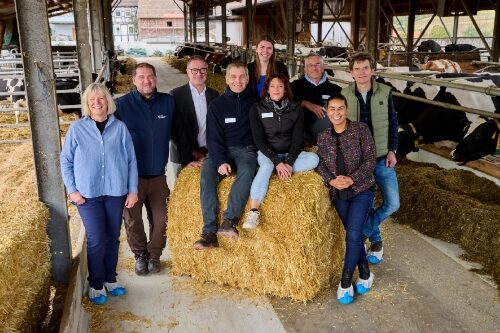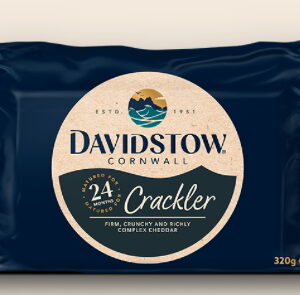Measuring climate change on-farm in Germay

Credit: Hochwald
In a final report on the ‘Climate Milk Farm’, a joint initiative between Nürtingen-Geislingen University of Applied Sciences (HfWU), Nestlé, Original Wagner Pizza and Hochwald Foods, the project’s partners have for the first time extensively documented the impact of climate protection measures on a representative dairy farm, the Frese Hof in Mörshausen (Hesse). The aim of the pilot project, which was launched at the end of 2021, was to demonstrate ways of making milk production more climate-friendly by 2050 without the economic viability of farms being compromised. The results have now been published in a comprehensive progress report, supplemented by practical fact sheets that evaluate the effectiveness and economic feasibility of the individual measures.
Measurable success in reducing CO2e emissions
The climate-friendly dairy farm is firmly integrated into the supply chain so that the reductions in CO2e can be transparently tracked from the farm right through to the product – in this case cheese for pizza production. Nestlé Germany supported the dairy farm run by its long-standing supplier Hochwald, which supplies, among other things, the mozzarella cheese for Nestlé Wagner pizzas. A number of operational and technical measures have been implemented and scientifically monitored since the start of the project. At the heart of the initiative is the measuring of emissions using the Cool Farm Tool (CFT) carbon footprint calculator.
The first step was to define a baseline value (‘point zero’) for the Frese farm based on the 2020/21 financial year. Emissions were then calculated annually to create a transparent picture of the impact achieved by the reduction measures. The reduction in CO2e per kilogram of milk in the 2024/2025 financial year was around 35 per cent, compared to the baseline value (2020/2021).
Detlef Latka, chief executive officer at Hochwald Foods explains, “The experiences gathered on the climate milk farm make clear that climate protection is essential for farming but it all costs money. Economic stability is impacted as a result – which makes practical, scientifically sound approaches to resolving this conflict of objectives all the more crucial.”
Oliver Schoß from Original Wagner Pizza adds, “A large proportion of our greenhouse gas emissions stem from the very start of our supply chain – from our raw materials. Our climate milk farm project has shown which measures are particularly promising for cheese production. We now need to share and implement these valuable insights with our partners along the supply chain.”
The most effective measures
Around 30 different measures were implemented, and they are divided into indoor management (barn, feeding, energy, manure management) and outdoor management (feed production, fertilization, crop cultivation). The most effective individual indoor measure is the fermentation of slurry/solid manure in an external biogas plant. The addition of a slurry additive and the use of a feed additive to reduce methane emissions produced during digestion also show great reduction potential. However, such additives are often cost intensive and not feasible without funding.
Controlling feed and feeding, using silage additives and intensive rearing of calf and young cattle increase feed efficiency and also reduce CO2e emissions. Crop cultivation measures such as legume/mixed cropping and carbon sequestration proved to be weather-dependent and couldn’t always be fully taken into account.
Dr Stephan Schneider from the University of Applied Sciences (HfWU) concludes, “The key takeaway is that just the implementation of good professional practices on a dairy farm leads to an improved CO2e footprint. For this to happen, the management of the farm has to be consistently optimized and professionalised. While individual indoor measures are environmentally, economically and socially beneficial, other measures pose problems on an economic/social level, meaning that farms can’t implement these themselves without support.”
Economic factors play a significant role in many of the measures. It is essential for farms implementing climate protection measures both short and long term that the legal and bureaucratic framework conditions are manageable and secure, and that economic costs don’t jeopardize business stability.
Experiences and challenges
The report emphasises that the farm manager’s motivation and sense of responsibility have been crucial to success. Mario Frese implemented a number of measures with support from the project team and managed a considerable amount of documentation. “Many of the measures don’t take a lot of effort to implement once they have been established. I’ll definitely continue using them on our farm,” says Frese.
There were, however, also challenges in the course of the project, for example in terms of carbon footprint accounting: Not all savings can be measured directly; many have an indirect impact – for example, through indoor efficiency gains. Plant-related measures are dependent on the weather, which makes it difficult to take them into account. Delays in funding processes led to provisional interim solutions in barn and feed management.
Transferability and outlook
The project will run through to April 2026 to collect further data. The results have model potential. Several measures, so-called “low hanging fruits,” were quick and cost-efficient to implement on the farm. Such low hanging fruits exist in varying degrees on every farm, depending on individual circumstances. The findings and results of the project will be incorporated into the Hochwald Milch Plus sustainability programme, supporting all member farms with the implementation of CO2e reduction measures, which will help to achieve climate targets along the entire value chain.






